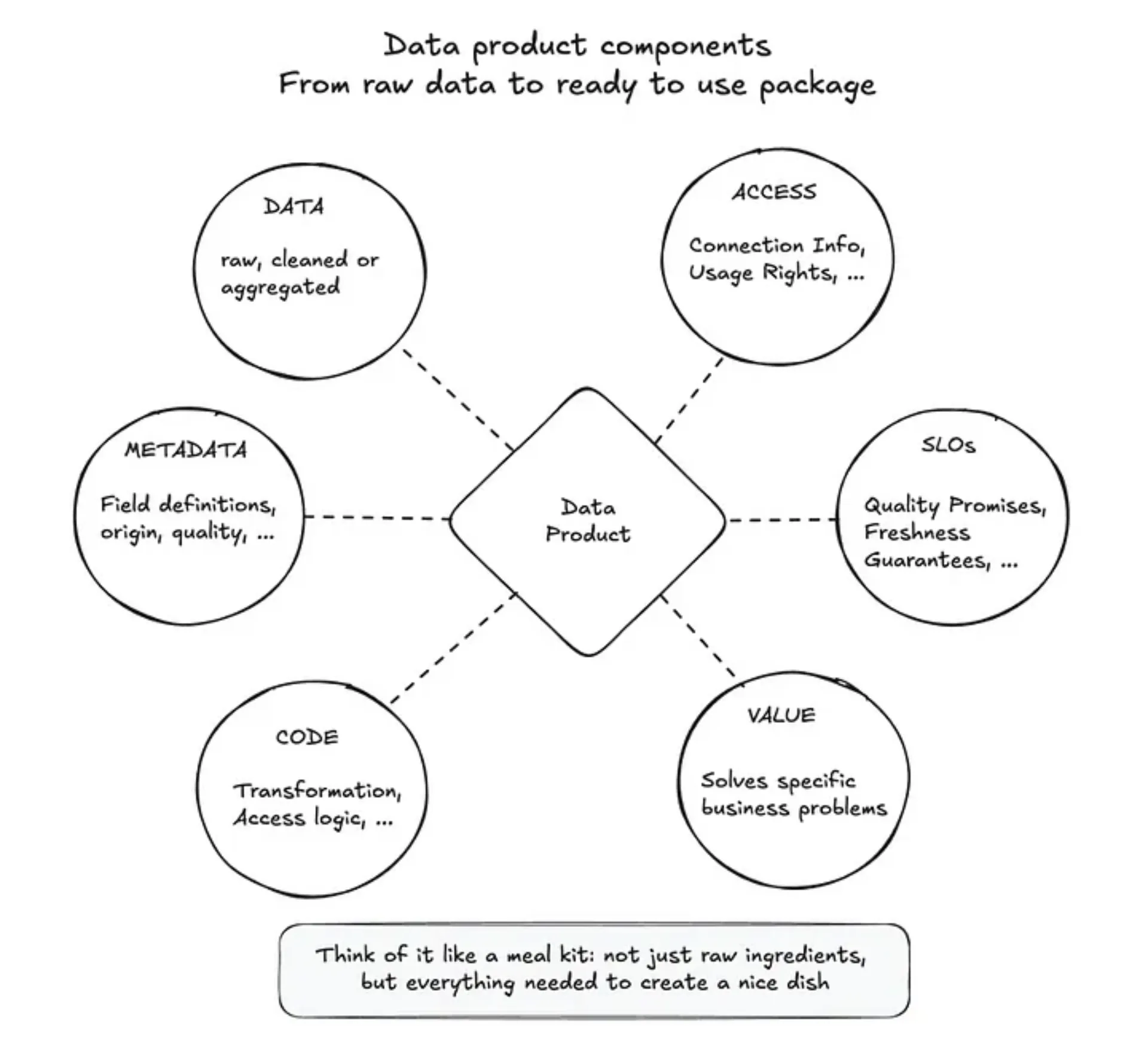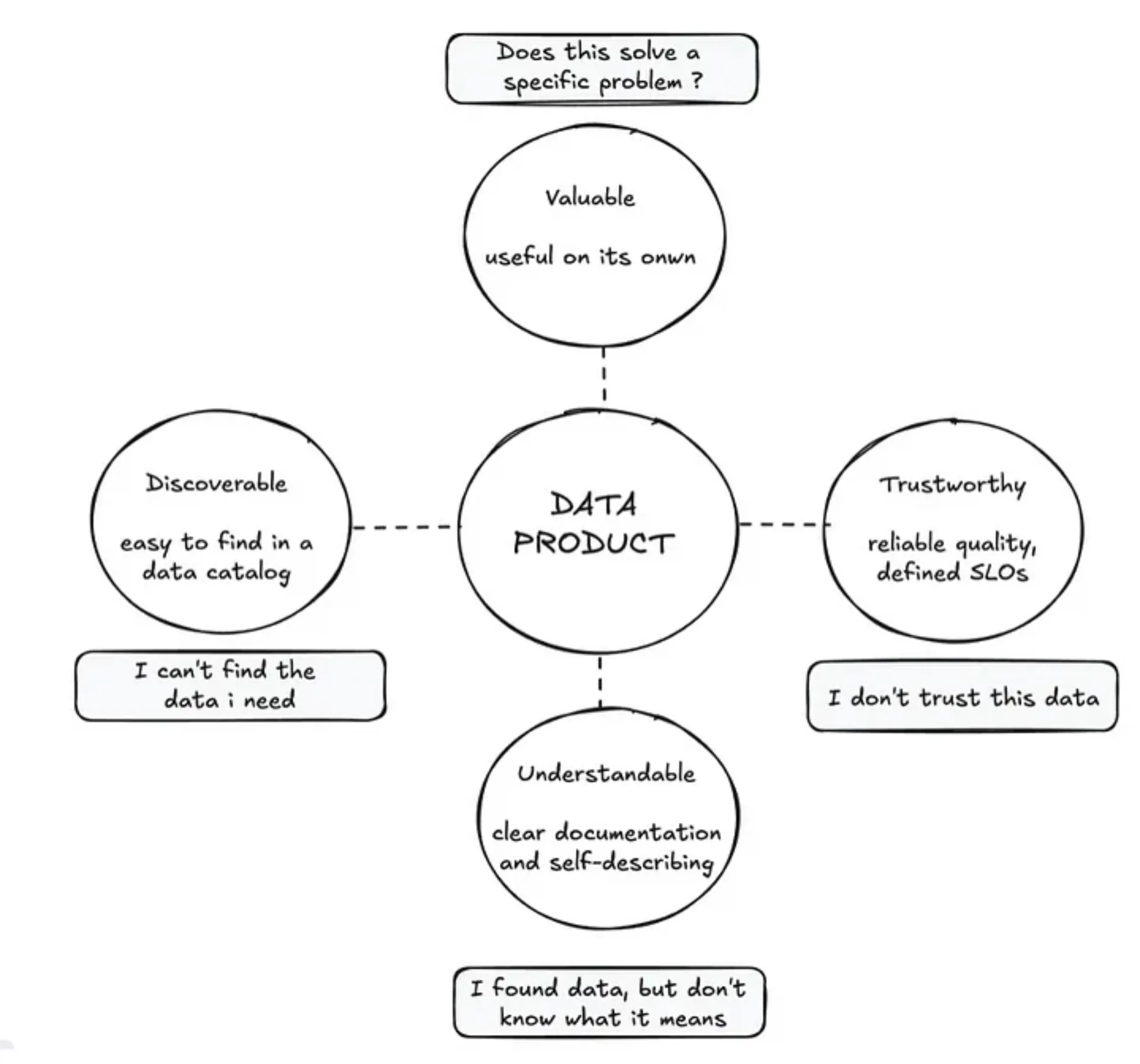

What Exactly IS a
‘Data Product’?
Demystifying the Buzzword — and Why It’s Crucial for AI Agents
Drowning in Data, Thirsty for Insights
Many organizations today find themselves swimming in data. Information pours in from sales systems, marketing tools, operational databases, websites, and countless other sources. Yet, despite this deluge, getting clear, trustworthy answers to business questions can feel surprisingly difficult. Data often seems trapped within different departments or systems, hard to find, difficult to understand, and sometimes unreliable. It’s a common frustration: plenty of raw information, but a real thirst for actionable insights.
What if there was a better way? What if, instead of treating data as a technical byproduct of operations, organizations started treating it more like a product? This means thinking about the data’s ‘consumers’ — colleagues, analysts, data scientists, other teams — as ‘customers’ and designing data offerings specifically to meet their needs effectively. This shift in perspective is at the heart of a concept gaining significant traction: the “data product.” It represents a move away from simply collecting data towards actively managing and packaging it as a valuable, consumable asset. This isn’t just a technical change; it’s a different way of thinking about data’s role and value within the business.
So, What IS a Data Product? (Keeping it Simple)
In simple terms, a data product is a ready-to-use, reliable, and understandable package of data designed for a specific purpose or audience. Think of it like the difference between getting a box of raw, unprepared ingredients delivered to your door versus receiving a complete meal kit. The meal kit not only contains the ingredients but also the recipe card, nutritional information, and perhaps even some pre-chopped vegetables — everything needed to easily prepare a specific meal.
Similarly, a data product isn’t just raw data. It’s a self-contained, deployable unit that bundles the data with everything required for its effective consumption.
This package often includes:
- The Data Itself: The core information, whether it’s raw, cleaned, aggregated, or derived.
- Metadata: Data about the data — descriptions of fields, definitions, origin, quality metrics (like a product label).
- Code: The logic used to create or access the data (e.g., transformation scripts, API access code).
- Access Information: How to connect to and use the data.
- Service Level Objectives (SLOs): Promises about its quality, freshness, and reliability.
The core idea is applying proven product development thinking to the data world. It’s about designing data solutions from the consumer’s point of view to solve specific problems or enable specific analyses, making it the smallest valuable unit of analytical data. It’s a deliberate effort to move beyond simply storing data to creating something genuinely fit-for-purpose and valuable on its own.

It’s crucial to distinguish data products from more traditional constructs in data engineering.
For instance:
Traditional Batch Loads: These are often nightly (or periodic) transfers of large volumes of raw or minimally processed data from source systems to a central repository like a data warehouse or data lake. While they serve a purpose for data consolidation, they typically lack the rich metadata, clear ownership, defined SLOs, and direct usability for specific business needs that characterize a data product. Consumers often need to perform significant downstream work to make this data usable.
Simple Data APIs: While APIs provide access to data, a simple API endpoint that merely exposes raw data tables or dumps data without comprehensive metadata, quality guarantees, or a clear definition of its intended use and lifecycle management isn’t a data product. A data product’s API is an interface to a well-managed, reliable, and understandable data asset, complete with all its supporting components.
This is where the concept of “data contracts” becomes highly relevant. A data product, with its explicit SLOs, schema definitions, metadata, and quality guarantees, essentially embodies a data contract between the producer of the data and its consumers. This contract ensures that consumers understand what they are getting, how they can use it, and what level of reliability they can expect. If the data product changes (e.g., schema evolution, changes in data semantics), the contract provides a framework for managing these changes and communicating them to consumers, thus preventing breakages in downstream processes and fostering trust in the data. Data contracts are a mechanism to enforce the reliability and trustworthiness inherent in the data product philosophy.
The Birth of the Data Product Idea
The term “data product” rose to prominence around 2019, largely thanks to Zhamak Dehghani of ThoughtWorks. She introduced it as a core principle — “Data as a Product” — within a broader architectural concept called Data Mesh.
Data Mesh itself emerged as a paradigm shift to address the limitations of traditional, centralized data approaches like data warehouses and data lakes, which often become bottlenecks in large organizations. Instead of one central team managing all data, Data Mesh advocates for decentralizing data ownership to specific business domains (like Marketing, Sales, Finance).
In such a decentralized world, having well-defined, high-quality, easily shareable data units becomes crucial. Data products serve as these essential building blocks, allowing different domain teams to create, share, and consume data effectively without relying solely on a central data team. Understanding this origin helps clarify why data products are becoming increasingly important: they are a key enabler for scaling data usage and innovation in modern, complex organizations by facilitating decentralized data sharing and ownership.
What Makes a Data Product Shine? (Key Qualities)
Not all data qualifies as a data product. To earn the title, it needs to possess certain characteristics that make it genuinely useful and reliable for its consumers. These qualities directly address the common frustrations people experience when trying to work with data. Key characteristics include:
1. Discoverable: Users need to be able to easily find the data products relevant to their needs, much like searching an online catalog. This often involves a dedicated “Data Product Catalog” where available products are listed and searchable. This tackles the “I can’t find the data I need” problem.
2. Understandable (Self-Describing): A data product should come with clear documentation and metadata explaining what it contains, what the fields mean, how it was created, and its intended use — like a clear product label. This addresses the “I found data, but I don’t know what it means or if it’s right for me” challenge.
3. Trustworthy: Consumers must have confidence in the data’s quality, accuracy, and timeliness. Data products achieve this by being transparent about their quality standards (often defined as Service Level Objectives or SLOs) and how well they meet them. Think of it like a trusted brand known for reliability. This counters the “I don’t trust this data” issue.
4. Valuable on its own: A data product should provide inherent value without necessarily needing to be combined with many other datasets to be useful. It represents a cohesive and meaningful information concept. This ensures users get something immediately useful, not just raw parts requiring complex assembly.
Other important qualities often include being Addressable (having a unique, stable location), Accessible (usable through standard tools like SQL or APIs), Interoperable (easy to combine with other data products), and Secure (with proper access controls). Together, these characteristics form the ‘contract’ between the data product’s producer and its consumers, ensuring a positive user experience.

Data Products in the Wild (Real-World Examples)
Data products aren’t just theoretical; they exist in many forms, often powering familiar applications and business processes. They go beyond simple datasets. Examples include:
Insight-Based Products: These deliver processed information ready for decision-making.
- A Sales Performance Dashboard showing key metrics like revenue, pipeline, and regional performance, curated for sales managers.
- A Credit Risk Score automatically calculated for bank customers to streamline loan applications.
- Personal Finance Insights provided by apps like YNAB or Mint, analyzing spending patterns.
Algorithmic / Automated Decision-Making Products: These use data to drive automated actions or complex recommendations.
- Recommendation Engines on platforms like Netflix or Amazon, suggesting movies or products based on user behavior.
- Predictive Analytics Tools like Zillow estimating home values or models predicting customer churn.
- GPS Navigation Apps providing real-time route guidance.
Master-Based Products: These provide a consolidated, standardized view of key business entities.
- A curated “Golden Customer Record” dataset combining information from CRM, sales, and support systems for a unified customer view used in marketing.
Dataset / Data as a Service Products: These provide access to curated or raw data, often via APIs.
- A Weather Forecast API used by various applications to display weather information.
- A dynamically priced Product Dataset for e-commerce, adjusting prices based on stock levels and expiration dates.
- Cleaned and documented Competitor Pricing Data provided as a spreadsheet or database table.
These examples illustrate the diversity of data products. Whether it’s a simple report, a complex machine learning model, or a foundational dataset, the common thread is the application of “product thinking” — designing, packaging, and managing the data asset for usability, reliability, and value.
Conclusion: Why Care About Data Products?
Treating data as a product isn’t just about adopting new jargon; it’s a practical approach to overcoming common data challenges. By focusing on the needs of data consumers and applying principles of product management, organizations can make their data more:
- Discoverable: Easier for people to find what they need.
- Understandable: Clearer meaning and context.
- Trustworthy: Higher quality and reliability.
- Accessible & Usable: Simpler to integrate into analyses and workflows.
Ultimately, the goal of data products is to break down data silos, foster collaboration, and empower more people across the organization to leverage data effectively for better, faster decision-making. It helps shift data from being a complex technical challenge to a readily available asset that fuels innovation and drives tangible business value.
Future Outlook: Data Products and the Rise of Agentic AI
The principles underpinning data products are poised to become even more critical with the rapid advancements in Agentic AI. Agentic AI systems, which are designed to autonomously achieve goals by interacting with their environment and utilizing various tools, depend heavily on access to reliable, understandable, and actionable data.
Here’s how data products can positively impact the use and adoption of Agentic AI:
Fueling Autonomous Agents: AI agents need high-quality, context-rich data to make informed decisions and perform tasks effectively. Data products, by their very nature, provide this:
- Discoverability: Agents can programmatically find the data they need through data product catalogs.
- Understandability: Rich metadata allows agents to interpret the data correctly.
- Trustworthiness: SLOs and quality guarantees ensure agents are operating on reliable information, reducing errors and improving the efficacy of autonomous actions.
- Accessibility: Standardized access mechanisms (like APIs designed for data products) make it easier for agents to consume data.
Enabling Complex Tool Use: Agentic AI often relies on using multiple tools and data sources. Data products can serve as standardized, reliable “tools” in an agent’s toolkit. An agent tasked with market analysis, for example, could seamlessly access a “Verified Sales Data Product,” a “Curated Competitor Insights Product,” and a “Real-time Social Sentiment Product” to synthesize a comprehensive report.
Improving Safety and Governance: As AI agents become more autonomous, ensuring they operate within ethical and safe boundaries is paramount. Data products with clear ownership, lineage, and built-in governance (e.g., access controls, usage policies embedded in the metadata) can help manage the data an agent is permitted to access and how it can use it. This supports responsible AI development.
Accelerating Agent Development and Deployment: When data is readily available in the form of well-defined products, developers can build and train AI agents more quickly. They spend less time on data wrangling and more time on the agent’s core logic and capabilities.
Facilitating Human-Agent Collaboration: When both humans and AI agents rely on the same trusted data products, collaboration becomes more seamless. Humans can easily understand the data an agent is using, validate its outputs, and intervene if necessary.
Connection to Entropic’s Model Context Protocol (MCP):
The vision for data products aligns strongly with emerging standards like Anthropic’s Model Context Protocol (MCP). MCP is an open protocol designed to standardize how AI models (including those powering agents) connect to and interact with external data sources and tools.
Data products can be seen as ideal candidates for exposure via MCP servers. By packaging data, metadata, access logic, and quality assurances into a data product, organizations create a ready-made, reliable “context source” that an AI agent can connect to via MCP. This offers several advantages:
- Standardized Access: MCP provides a “USB-C port for AI,” a standardized way for agents to plug into diverse data sources. Data products, when exposed through MCP, become easily consumable building blocks for any MCP-compliant agent.
- Enhanced Context for LLMs: Agentic systems often leverage Large Language Models (LLMs). Data products can provide rich, structured, and trustworthy context to these LLMs via MCP, leading to more accurate, relevant, and reliable responses and actions from the agent. Instead of an LLM relying solely on its training data, it can access fresh, domain-specific, and high-quality information from dedicated data products.
- Secure and Governed Data Exchange: MCP aims to enable secure connections. When data products with their inherent security and governance features are accessed via MCP, it reinforces controlled access to sensitive information for AI agents.
In essence, data products provide the well-structured, reliable, and governed “what” (the data asset itself), while protocols like MCP provide the standardized “how” (the mechanism for AI agents to access and use that asset). Together, they can significantly accelerate the development and trustworthy adoption of sophisticated Agentic AI systems, allowing them to leverage organizational data more effectively and safely to deliver business value.












